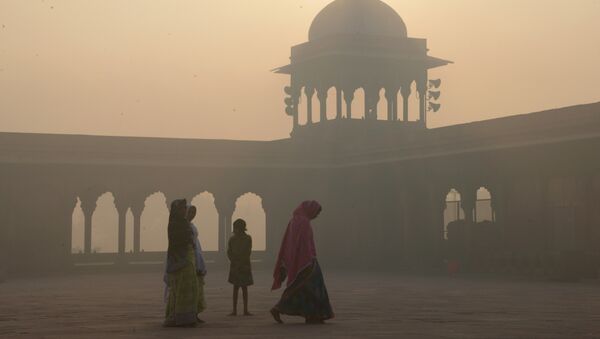In a spacious prayer hall inside a mosque in Beijing's Xicheng district, more than 100 women in colorful embroidered headscarves, young and old, were praying earnestly on the carpet.
Above their heads, the voice of a male imam leading prayer in another mosque nearby emitted from loudspeakers.
During the Muslim holy month of Ramadan, which runs from May 27 to June 26 this year, hundreds of women will attend religious services every day at a women-only mosque, just down the road from Beijing's most famous Muslim prayer hall at the Niujie Mosque.
While Muslim women face restrictions in most mosques around the world, either being segregated by sex within the building or in some communities being banned from entering altogether, many Chinese Muslim women pray at institutions dedicated to serving their gender, a unique Chinese tradition.
"China's women-only mosques are the best representative of religion with Chinese characteristics. It's a signature building that shows our respect for women," Liu Jun, director of the Niujie Mosque, told the Global Times.
"Besides serving as a platform for Muslim women to pray and learn about the religion, women-only mosques now also have a new identity — a platform to forge international communication as women from Arab countries like to visit as their countries don't have such mosques," he added.
Chinese characteristics
Beijing's first women-only mosque was built in 1921 in Xicheng's Shouliu Hutong. The mosque was destroyed in 1997 amid a wave of demolitions of buildings considered dilapidated by the local government. In 2005, the government rebuilt the new Niujie Women's Mosque, near its old location and the Niujie Mosque.
During Ramadan, Gui Jianrong hauls herself from bed at 2 am and rushes to the Niujie Women's Mosque for prayers.
Besides prayers, the 54-year-old and several other women also shoulder the responsibility of preparing meals for local men and women to break their daily fast.
Liu, referencing Chairman Mao's famous statement, said that Muslim women "hold up half the sky" and are encouraged to play a big part in community activities.
According to Liu, in some Muslim communities in China and abroad there are no women-only mosques and women have to pray at home.
There is no official data on the number of women-only mosques in China. Professor Shui Jingjun of the Henan Academy of Social Sciences wrote in her book The History of Women's Mosques In Chinese Islam that such mosques first proliferated in China's central plains which include parts of Henan, Hebei, Anhui, Shanxi and Shandong provinces. The Ningxia Hui Autonomous Region also has women-only mosques, but they have not been a traditional part of Islamic practice in the Xinjiang Uyghur Autonomous Region.
Liu said that the emergence of women-only mosques was a result of the intermixture of Chinese and Islamic traditions. Chinese Islam has been influenced by the dominant culture of the nation which has not traditionally barred women from public life, he said.
He noted that the largest single Muslim community in China is the Hui. The Hui largely claim descent from Arab traders who came to China as early as 13 centuries ago and settled in China, intermarrying with locals. This ethnic mixture is reflected in their religious practices. "So we have characteristics of Han culture, which is inclusive," said Liu.
Besides the influence of their mixed origins, Shui's book offers another explanation for the existence of women-only mosques.
When Muslims first came to China during the Tang Dynasty (618-907), they were honored guests. But during the Ming Dynasty (1368-1644), Chinese Muslims fell out of favor with the authorities and were subject to repression. Under this persecution, the Muslim community had to make the most of its resources to ensure its cultural survival, and hence Muslim women had to help bear the responsibility of transmitting the faith.
So as early as the middle of the 17th century, religious schools especially set up for educating female Muslims emerged. During the late Qing Dynasty (1644-1911), these schools developed into women-only mosques.
Her community
Ma Yun, 27, works in human resources in Beijing. She brings her 2-year-old daughter to the Niujie Women's Mosque during Ramadan to pray. In her hometown in China's northwest, her female family members pray at home as their area has no women-only mosque.
She first visited a women-only mosque when she visited Lanzhou, Northwest China's Gansu Province, at the age of 13. "While we could learn about the Koran and pray at home, I really liked the scholarly atmosphere at the mosque," she said.
Women-only mosques aren't only places for female Muslims to learn about their religion, but also an important resource for illiterate women, especially seniors, to learn basic knowledge, according to Ma.
In rural areas, some women often learn to read and write in their local mosque under the tutelage of a female imam, another unique feature of Chinese Islam.
Wang Jingxian, a Hui Muslim, first visited the Niujie Women's Mosque when she was 6 years old.
Back then, there was a female imam who taught them the Koran sentence by sentence and led their prayers.
This early childhood experience is still clearly remembered by 66-year-old Wang. "Although I couldn't quite understand what the imam said at such a young age, I was still empowered," she said.
According to Wang, she comes from a religious family which was quite prominent in Beijing's Muslim community back then. Several Beijing imams came from her family.
She may have followed in their footsteps to become an imam herself if the Cultural Revolution (1966-76) had not intervened.
During the Cultural Revolution, when people were encouraged to "smash the Four Olds," the mosque was shut down and the female imam fled. The Four Olds included old ideology, old culture, old habits and old customs.
"I then had to leave Beijing and went to the countryside in [Northeast China's] Heilongjiang Province," she said.
Religious practices of all kinds were banned during the Cultural Revolution. It wasn't until the 1980s that religion returned to public view and female imams reappeared.
After coming back to Beijing, Wang had no time to pursue her studies as the demands of work and domestic chores left her with no spare time.
She said she resumed studying the Koran just a few years ago, which gives her "spiritual fulfillment."
In the Niujie Women's Mosque, she has also made friends with other Muslim women and they regularly organize study classes. "I feel quite happy now. With the support of the Party, government and society, I now enjoy religious freedom," she said.
"But I would still prefer to have a female imam. It would be more convenient to learn from, talk with and practice with a female imam, to satisfy our craving for knowledge. We need to be more restrained when meeting a male imam," she said.
Liu, head of the Niujie Mosque, explained that because the Niujie Mosque already has 10 male imams they don't need a female imam.
A renewing phase
Liu Jun told the Global Times that the wives of ambassadors from Arab countries, including Oman, like to visit the Niujie Women's Mosque during Ramadan.
"They show a strong interest in this kind of mosque which doesn't exist in their own country," he said.
Several days before Ramadan began, the mosque received thousands of Muslim tourists from Malaysia in one week who paid special visits to the women-only mosque.
Ma told the Global Times that these days young Chinese Muslims learn about the Koran from Islamic websites and books. But she feels that it's still necessary to have women-only mosques and female imams.
"It's still too difficult for me to process the information I read online and in books by myself," she said.
According to Liu and Wang, in the last two years they have seen more and more young Muslim women coming to the mosque for prayers, many of whom are college students.
Gui said that when she first came to the Niujie Women's Mosque in 2004, when she was in her 40's, she was the youngest woman there.
Liu attributes the growth in youthful enthusiasm for Islam to the greater promotion of the religion on social media, which has made young people feel closer to their faith.
But the latest developments also bring new challenges. Shui mentioned in her book that female imams, most of whom are now elderly, are unable to meet the demands of well-educated young Muslim women.
Traditionally, female imams have focused on the importance of prayers and have taught scripture in Farsi. But today female Muslims would rather learn scripture in Arabic, according to Shui's book, a language in which many female imams are not proficient. While teaching methods used by male imams have changed with the times, female imams have tended to be more conservative, which has posed difficulties to the development of women-only mosques, Shui wrote.
Wang said that the development of women's mosques first needs greater public understanding of female Muslims.
Many people, including people in Niujie, "like to question us about why we dress this way during the summer heat and look at us through colored spectacles, which discourages female Muslims from showing their presence in public life," Wang said.
This article was originally published in the Global Times.






